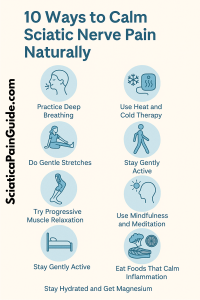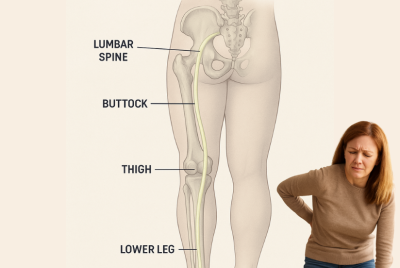How to Calm Sciatic Nerve Pain: Simple Techniques to Soothe Pain and Relax Your Body Naturally
When Sciatica Pain Feels Unbearable
If you’ve ever experienced that sharp, shooting pain radiating from your lower back down your leg — or that dull, burning ache that just won’t go away — you know how disruptive sciatic nerve pain can be. Millions of Americans struggle with sciatica each year. It can make sitting, walking, or even sleeping feel like a challenge. While medication and physical therapy have their place, many people find lasting relief through natural calming techniques that relax the body, reduce inflammation, and ease nerve tension. In this guide, we’ll explore how to calm sciatic nerve pain using gentle movements, breathing exercises, posture adjustments, and stress-relief habits you can start today.
Understanding Sciatic Nerve Pain
The sciatic nerve is the largest nerve in your body, running from your lower spine through your hips and buttocks and down each leg. When it becomes irritated or compressed — often by a herniated disc, muscle tightness, or inflammation — pain can spread along its path.
Common symptoms include:
-
Sharp or burning pain in the lower back, hip, or leg
-
Numbness or tingling down one side
-
Weakness or stiffness in the affected leg
-
Pain that worsens when sitting or standing too long
Sciatic pain is not just physical — it can also be emotionally draining, increasing stress, tension, and anxiety that further tighten muscles and worsen pain.
That’s why learning to calm both your body and your mind is key to long-term relief.
🧘♀️ How to Calm Sciatic Nerve Pain Naturally
Below are evidence-based techniques to help you reduce nerve irritation, relax tense muscles, and restore calm to your entire body.
1. Practice Deep Diaphragmatic Breathing
Deep breathing stimulates the vagus nerve, which helps shift your body from “fight or flight” to “rest and digest” mode. This reduces muscle tension and inflammation — both of which can aggravate sciatic pain.
How to do it:
-
Sit or lie down comfortably.
-
Inhale deeply through your nose for 4 seconds, expanding your belly.
-
Hold for 2 seconds.
-
Exhale slowly through your mouth for 6 seconds.
-
Repeat for 5 minutes, twice a day.
👉 Deep breathing helps relax the lower back and hip muscles, lowering pressure on the sciatic nerve.
2. Use Heat and Cold Therapy for Nerve Calm
Cold therapy reduces inflammation and numbs sharp pain, while heat therapy relaxes tight muscles and improves blood circulation.
Try this combo:
-
Apply an ice pack for 15 minutes to reduce swelling.
-
Follow with a warm compress or heating pad for another 15 minutes to relax muscles.
Alternate 2–3 times daily.
Tip: Use heat before stretching and ice afterward to maximize results.
3. Gentle Stretches to Release Nerve Pressure
Tight muscles — especially in your lower back, glutes, and hamstrings — can trap or irritate the sciatic nerve. Gentle stretching helps release that tension safely.
Best calming stretches for sciatic pain:
-
Knee-to-Chest Stretch: Lie on your back, pull one knee toward your chest, and hold for 20–30 seconds.
-
Piriformis Stretch (Figure 4): Cross one ankle over the opposite knee, then pull your thigh toward your chest.
-
Child’s Pose: Kneel, sit back on your heels, and stretch your arms forward on the floor.
-
Cat-Cow Stretch: Alternate arching and rounding your spine while breathing deeply.
Perform these stretches daily, moving slowly and avoiding any sharp pain.
4. Try Progressive Muscle Relaxation
This technique helps calm the mind and relieve the muscle tension that often worsens sciatica pain.
How to do it:
-
Lie on your back in a comfortable position.
-
Starting at your feet, tense the muscles for 5 seconds, then release.
-
Move up your body — calves, thighs, hips, abdomen, shoulders — relaxing each group in turn.
-
Breathe slowly as you go.
👉 This method teaches your nervous system how to let go of tension and ease pain naturally.
5. Maintain Good Posture
Bad posture increases pressure on the lower spine and can irritate the sciatic nerve.
Posture tips for calm and comfort:
-
Sit with your back supported and feet flat on the floor.
-
Avoid crossing your legs.
-
Use a small lumbar pillow for lower back support.
-
If you work at a desk, stand up and stretch every 30–45 minutes.
Even small posture improvements can significantly reduce flare-ups.
6. Stay Gently Active
It’s tempting to rest when you’re in pain — but staying immobile can make things worse. Light movement keeps your muscles flexible and your blood flowing.
Try:
-
10–15 minute walks twice daily
-
Light yoga or swimming
-
Water-based exercises for low-impact relief
Movement also helps your brain release endorphins, your body’s natural painkillers.
7. Support Your Sciatic Nerve While Sleeping
Your sleep position matters more than you think. The wrong one can compress the nerve, while the right one promotes healing.
Sleep tips:
-
Side sleepers: Place a pillow between your knees to keep your spine aligned.
-
Back sleepers: Put a small pillow under your knees to reduce lower back strain.
-
Avoid stomach sleeping, as it twists the spine.
Also, aim for 7–9 hours of quality sleep — your body heals most during rest.
8. Use Mindfulness and Meditation
Chronic sciatica often leads to stress and anxiety, which tighten muscles and intensify pain signals. Mindfulness meditation helps break this cycle by teaching you to observe pain calmly without panic.
Try this simple exercise:
-
Sit quietly and focus on your breath.
-
When you feel pain, notice it without judgment — simply breathe through it.
-
Repeat 10 minutes a day.
Over time, mindfulness lowers your body’s stress response and improves pain tolerance.
9. Eat Foods That Calm Inflammation
Your diet directly affects inflammation levels — and by extension, nerve pain.
Eat more of these calming foods:
-
Fatty fish (salmon, tuna, mackerel)
-
Berries, leafy greens, and sweet potatoes
-
Olive oil, turmeric, and ginger
-
Walnuts, flaxseeds, and chia seeds
Avoid:
-
Processed meats, refined sugar, and fried foods
-
Excess alcohol and caffeine
👉 Eating anti-inflammatory foods can make your body less reactive to nerve irritation.
10. Calm the Nerves with Hydration and Magnesium
Dehydration and low magnesium can both cause muscle tightness and nerve irritation.
Tips:
-
Drink 6–8 glasses of water daily.
-
Eat magnesium-rich foods like bananas, spinach, almonds, and avocados.
-
Consider a gentle magnesium supplement (consult your doctor first).
These small changes can help relax your muscles and keep nerve signals balanced.
🌿 Bonus: Natural Remedies for Soothing Sciatica
-
Epsom salt baths: Magnesium in the salts helps relax sore muscles and reduce inflammation.
-
Essential oils: Peppermint, lavender, and eucalyptus oils can soothe pain when mixed with carrier oils and massaged gently.
-
Acupressure mats: Stimulate blood flow and relax tension points along your lower back and legs.
-
Foam rolling: Roll gently over the glutes and thighs to release tightness — avoid direct rolling on the spine.
🧠 The Mind-Body Connection: Why Relaxation Matters
When you’re stressed or anxious, your nervous system stays in a heightened state of alert. This increases cortisol and muscle tension, which amplify pain signals from the sciatic nerve.
Calming techniques like deep breathing, meditation, or gentle yoga reset the nervous system, reduce inflammation, and lower pain perception.
In other words — the calmer your body feels, the calmer your nerve becomes.
⚠️ When to See a Doctor
While these calming methods help most people, see a healthcare provider if you experience:
-
Sudden or severe pain that doesn’t improve after two weeks
-
Weakness or numbness in your leg or foot
-
Loss of bladder or bowel control
-
Pain following a serious fall or accident
These symptoms may indicate severe nerve compression that requires immediate medical attention.
FAQs About How to Calm Sciatic Nerve Pain
1. How can I calm sciatic nerve pain fast?
Try cold and heat therapy, gentle stretching, and deep breathing. These methods quickly reduce inflammation and muscle tightness.
2. Does walking help calm sciatica?
Yes, short daily walks improve circulation and flexibility, which can reduce pressure on the nerve.
3. Can stress make sciatic pain worse?
Absolutely. Stress increases muscle tension and inflammation. Calming the nervous system through breathing or meditation helps relieve pain.
4. What position helps calm sciatic nerve pain?
Sleeping on your side with a pillow between your knees or lying on your back with a pillow under your knees can help.
5. Can massage help sciatic nerve pain?
Yes, massage relaxes tight muscles (especially in the hips and lower back) that often compress the nerve.
6. How long does it take to calm sciatica naturally?
Mild cases can improve in 2–4 weeks with consistent stretching, posture correction, and inflammation control.
7. Does hydration help sciatica?
Yes. Staying hydrated keeps spinal discs healthy and muscles flexible, reducing irritation around the sciatic nerve.
Conclusion: Calm Your Body, Calm Your Nerves
Sciatica doesn’t have to control your life. By learning how to calm sciatic nerve pain naturally, you can ease discomfort, improve mobility, and reclaim peace of mind — one day at a time.
Focus on gentle movement, mindful breathing, and daily self-care. When your body and nervous system work together, true healing begins from within.
Disclaimer
This article is for educational purposes only and should not replace medical advice, diagnosis, or treatment. Always consult a qualified healthcare professional before beginning new exercises or therapies for sciatica.

- How to Relieve Sciatic Pain
- Sciatica Pain After Standing Too Long
- How to Treat Very Painful Sciatica





